An international jury was headed by the well-known U.S. film director Joel Schumacher, know for such works as A Time to Kill, Batman and Robin, and Phone Booth. “I have a special affinity for the Okinawan Movie festival,” Schumacher said, “because of its strong community angle. This concept makes the festival a place for building peace and cultural understanding between people and is an important message from Okinawa. ”
This year`s festival attracted nearly 450,000 people, mostly from Okinawa, who milled around the Convention Center in Ginowan City to watch films and catch a glimpse of the stars gracing the red carpet and speaking to the audience following their film’s screening.
Special audience programs included workshops on film and acting for school children who were on spring vacation.
“I am so glad I came to the festival this year for the second time,” said 15-year-old Rika Daimon, who came with her friends from Naha. “The festival gives Okinawa, which is usually behind other big cities in Japan, an international standing and people like us a valuable opportunity to meet important movie stars.”
The film festival, originally inaugurated in March 2009, runs on the central theme of Laughter and Peace, which is linked to Okinawan traditional wisdom that laughter is the celebration of life.
The festival is the brainchild of Yoshimoto Kogyo Company, Japan`s leading entertainment enterprise, which works closely with the Okinawan prefectural government to hold the event. “Bringing the film festival to Okinawa is important to make the island a hub for Asian entertainment,” said Hiroshi Osaki, chairman of Yoshimoto Kogyo Company.
Apart from the galaxy of well-known Japanese and Asian films that were featured during the week-long festival, this year included a new category called “the local origination project,” which screened community-based movies. “Okinawan Language,” a documentary film on life in Chatan-cho, in the central part of Okinawan island, emerged as am audience favorite in the new category. Talking to the gathered viewers, director Rinken Teruya explained the film’s intention to highlights the need to protect the fast-disappearing Okinawan language that represents the unique culture of the Riyukyu islands of Okinawa prefecture.
This year, the highly competitive peace award was extended to Taiwanese film director Tien-Yu Fu for her film “The Happy Life of Debbie.” The movie features the lives of Southeast Asian wives who marry Taiwanese men and start a new life in their host country. Fu, delighted to have won, said the Okinawa film festival is a gateway to Asia. “I am so glad my film was chosen in Okinawa. The festival brings Asian culture to the world,” she said.
As Japan`s most southern prefecture, close to Taiwan, Okinawa is home to two thirds of the U.S.’ military bases in the country and had most recently been in the news for its increasingly strained relationship with army personnel on the islands.
With its celebration of local and regional culture, the rapidly growing film festival may be striking just the right cord for local audiences, while simultaneously giving a good polish to Okinawa’s international image.
* Suvendrini Kakuchi is a Sri Lankan journalist based in Tokyo and writes for IPS news agency.
]]>
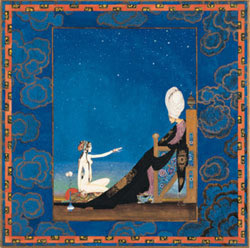 Espero entre indignada y divertida el próximo 8 de marzo, Día Internacional de la Mujer… El anterior me deparó una pasmosa sorpresa. Sobre mi escritorio había una enorme rosa de pétalos amarillos y bordes rojos y una tarjeta dirigida a las mujeres del siglo XXI, en su día.
Espero entre indignada y divertida el próximo 8 de marzo, Día Internacional de la Mujer… El anterior me deparó una pasmosa sorpresa. Sobre mi escritorio había una enorme rosa de pétalos amarillos y bordes rojos y una tarjeta dirigida a las mujeres del siglo XXI, en su día.
“Las mujeres han seducido a los literatos, han vuelto frescos a los piadosos, han empobrecido a los ricos…” “… para ellas se construyen los palacios, se tienden las cortinas, se compran los esclavos y corren las lágrimas…” “para ellas son el almizcle, las joyas y el ámbar, por su causa se reúnen los ejércitos, se construyen los cuarteles, se almacenan las provisiones y se cortan los cuellos…”
El texto es una cita de “Las Mil y Una Noches”, la célebre compilación de cuentos árabes del siglo XI. Y el remitente del supuesto elogio al eterno femenino, Random House Mondadori.
¿Por qué escogieron este texto los encargados de relaciones públicas de Random House Mondadori? Apuesto que les pareció un conjunto de alabanzas y zalamerías exóticas, impactantes y perfumadas.
Pero, ¿cuál es la imagen femenina que describen estas citas? Una creada en el medioevo por el mundo masculino. La mujer era capaz de enloquecer o arruinar al hombre, de hacerlo embarcar en las empresas más locas, audaces y crueles, un ser por el que valía la pena saquear, esclavizar, matar…
Ese ser, casi mítico, funcionaba como justificación literaria y poética de las reglas de juego que regían el mundo masculino de entonces: el dominio a toda costa y la acumulación de territorios y riqueza.
Las mujeres reales de esa época, a las que se dirigían esos dudosos elogios, permanecían, por ejemplo, esclavizadas en un harén.
“Las Mil y Una Noches” es un relato que da a pie a otro: El sultán Shahriar asesina a su esposa cuando descubre que le es infiel y, a partir de entonces, ordena que se le presente cada día una nueva mujer, que pasa con él la noche y al amanecer es ejecutada.
Una locura cruel. Pero con nuestros ojos del siglo XXI podemos verla como lago más: una perfecta muestra de violencia sexista, perpetrada con total alarde de poderío.
Entonces, la joven Sherezade rompe ese círculo de muerte: urde el plan de fascinar al sultán con el relato de un cuento y dejarlo inconcluso justo al amanecer, con la promesa de terminarlo a la noche siguiente. Así logra sobrevivir mil noches y, al final, consigue que el castigo le sea perdonado a ella y a todas las que la hubieran seguido.
Sherezade es un símbolo, como lo es el sultán. Hoy, la elección de la cita elegida por el gigante editorial también tiene significado simbólico.
Random House Mondadori Sociedad Anónima es, según su propia definición, uno de los líderes en edición y distribución de contenidos escritos en lengua española.
Es un emprendimiento de riesgo compartido entre Random House, división editorial de Bertelsmann AG, la mayor empresa internacional de comunicación, comercio electrónico y contenidos interactivos, y Mondadori, editorial que posee un tercio del negocio de libros y revistas en Italia, una de las propiedades del primer ministro italiano Silvio Berlusconi.
Random House es el mayor grupo editorial del mundo.
Desde 2001 forman parte de Random House Mondadori todos estos sellos:
Areté, Beascoa, Caballo de Troya, Debate, DeBolsillo, Collins, Electa, Grijalbo, Lumen, Mondadori, Montena, Plaza & Janés, Rosa dels Vents, Sudamericana.
Distribuye y exporta sus títulos a más de 45 países de América Latina, Asia, Europa y Estados Unidos.
Bertelsmann AG opera en 63 países y da empleo a más de 100.000 personas. Posee empresas de radiodifusión, editoras de revistas y de libros, sellos discográficos, el mayor grupo de distribución de libros y de música, logística, diseño y contenidos multimedia, entre otros negocios.
Literalmente, grupos como Bertelsmann AG tienen el poder de imponer ideas, modelos, contenidos. Decenas de miles de periodistas, escritores y comunicadores trabajan para estas empresas.
Pero su influencia va mucho más allá, porque crean y sostienen cultura y formas de ver, que se reproducen fácilmente en cada sala de redacción, por pequeña que sea. Y en cada calle. Son un posmoderno sultán Shahriar.
¿Qué es lo mínimo que la sociedad de hoy debería exigir a medios tan poderosos? Por lo menos que los contenidos con los que dejan semejante huella cultural sean un reflejo de este mundo, el del siglo XXI, y no uno del siglo XI.
Claro, este mundo no es precisamente un mar de rosas.
Las mujeres siguen siendo objeto de violencia y atropellos, aunque ya quede mal decir que todo se hace en nombre de su belleza. Y la presencia femenina sigue siendo poca y distorsionada en los medios de comunicación.
El 10 de noviembre del año pasado, el Proyecto de Monitoreo Global de Medios llevó a cabo su cuarta investigación para evaluar “cómo ha ido cambiando la representación de género en los medios de comunicación” de distintas regiones del mundo. Los resultados estarán listos a tiempo para la conferencia que las Naciones Unidas celebrarán en marzo, en Nueva York, con motivo de los 15 años de la Cumbre de Beijing.
Algunos resultados del estudio anterior, de 2005, indican que las mujeres eran apenas 21 por ciento de los actores de las noticias (y los hombres el restante 79 por ciento), 17 por ciento de las fuentes expertas y 14 por ciento de las portavoces, pero duplicaban a los hombres entre las fuentes que eran víctimas.
En fin, no necesitamos más sultanes, ni tampoco queremos más Sherezades. Necesitamos estar alerta.
]]>I feel neither more “good” nor more “patient”. I am a hard-headed woman, as always. Attached to life, as ever!
The day when my friend Pigi, my oncologist, told me that I had breast cancer, I cried desperately. The first thing I did was to phone my [...]]]>
I feel neither more “good” nor more “patient”. I am a hard-headed woman, as always. Attached to life, as ever!

Paola Rolletta by Luis Abelard
The day when my friend Pigi, my oncologist, told me that I had breast cancer, I cried desperately. The first thing I did was to phone my partner to tell him this piece of news, of which I had had some premonition. And I understood that premonition really exists.
Curiously, I did not wonder “Why me?” My reaction was: “This cursed disease has hit me too!”
Perhaps some survival instinct made me articulate my feelings in this way, to ease the pain in my heart.
There are more and more of us, women between 40 and 50 years of age, diagnosed with cancer, most of hormonal origin. I must read more about the disease: until now, I have not allowed myself such reading.
First I said that I couldn’t read more about cancer until I finished this calvary of chemotherapy. Now that I finished the eight sessions, I say that I will wait to read until I have the CAT (computer axial tomography) results.
In a nutshell, I don’t want to cram on cancer because I decided to trust my three doctors, the surgeon, the oncologist and the nutritionist, to save me from this darkness.
In darkness
What shocked me most is the darkness you live through while undergoing chemotherapy. It is almost like a mirror lysergic acid experience, but instead of colourful hallucinations, they are black, like anti-matter.
Maybe it is the chemicals shot into my body during six months (eight chemo sessions, 4 FEC and 4 Docetaxel, every 21 days) that makes me see the world, inside and outside, so dark.
The darkness weighs more heavily than the hair loss, the nausea and the vomiting. This metaphysical darkness that totally grabs you is devastating: no words, gestures, musical notes or flowers. For a long time, darkness dominated my thoughts and my soul – an unnatural darkness that does not spring from disease-associated pessimism.
To find strength, I tell myself that mine is a chemical pessimism that – I hope, I trust – will save my life.
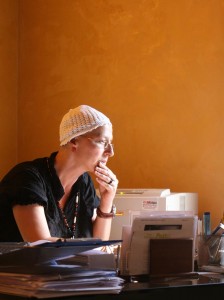
Photo: Sol de Carvalho
And I hope that radiotherapy next month will be less dark!
Feeding nitro-glycerine to my body
Earlier this year, I wanted to quit smoking and went to the naturopath for acupuncture. In her office by the sea in Maputo, Dr. Fernanda examined me and told me, without mincing words, to have a mammogram right away. Because I smoked and took birth control pills for decades, I was literally feeding a cancer with all that poison, that nitro-glycerine, she said. Just like this. Raw and cruel.
I was so frightened I took the first flight back to my home country, Italy. That saved my life! Dr. Fernanda was right, in her cruel way. Even when I did not have any symptoms, even though I had not felt any lump, she was right.
Cancer is a multi-factor disease but breast cancer is, most cases, of hormonal origin. Why these hormones go crazy and make us develop cancer it is not known yet, but that they are to blame, this is known. This knowledge is a great leap forward to cure many cancer patients and to prevent the disease.
Ten years ago I read “Illness as a Metaphor” by Susan Sontag while I was working on a documentary on AIDS in Uganda for Portuguese TV.
Ten years later, I re-read it. I tracked it down in the boxes where I stored my books when I moved to Maputo.
In the meantime, Susan Sontag died of cancer. I remember her, wearing a green dress, in a photo taken by her lover Annie Leibovitz.
Every day I repeat to myself Sontag’s call to realism: cancer can be treated with chemotherapy more efficiently than with diets or psychotherapy. Sontag unpacked beliefs that have fed the popular mythology about cancer up to these days.
Every day I repeat her words in the introduction: illness is the night-side of life, a more onerous citizenship.
The disease that has hit me contains, paradoxically, an element of reassurance: every day I must face a new day, a daily routine. Suffering serves as a mediator between my will to live and all that is threateningly unknown. But the unknown is part of life itself. It is life.
]]>Center for the Study of AIDS, University of Pretoria, South Africa
Fabrications is the theme of the 2010 calendar produced by the Center for the Study of AIDS. The gorgeous images are digitally manipulated African textiles.
The notion of “fabrications” was inspired by the many [...]]]>
Center for the Study of AIDS, University of Pretoria, South Africa
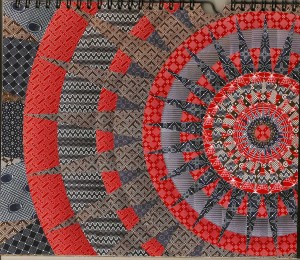 Fabrications is the theme of the 2010 calendar produced by the Center for the Study of AIDS. The gorgeous images are digitally manipulated African textiles.
Fabrications is the theme of the 2010 calendar produced by the Center for the Study of AIDS. The gorgeous images are digitally manipulated African textiles.
The notion of “fabrications” was inspired by the many stories of the AIDS quilts – designed to tell a story about someone who had died of AIDS, to honour them and to create a memorial to them that could be used as part of the fabric of people’s daily lives.
A fabrication is in this sense both a physical construction of fabrics, but also a psychological and social construction, the story of a life.
We need to tell people’s stories but we also need to acknowledge that we use stories to make sense of AIDS, to cope with it, to fashion it into something bearable, to give it meaning.
Story telling is a universal art form, but has a special significance for Africa. This calendar looks at different African fabrics, each telling a story about its creator and its country. The calendar offers ways to take these designs to tell new stories and produce new “fabrications”. 
Many of the AIDS quilt stories had elements of “fabrication”, in that they were a blend of truth, memory and fantasy. It is the fantasy and fiction that is just as fascinating as “the truth”.
In the same way as people mythologized the dead, we as societies deal with HIV and AIDS by creating myths and fabrications of the epidemic, to cope with and make sense of it.
There are the myths of virgin protection, the myths of HIV in oranges, the myths of worms in condoms, of deliberate infection through syringes, and many other myths that are part of the fabric of dealing with HIV and AIDS.
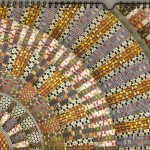 But there are other fabrications and fantasies as well – that routine testing is a prevention strategy and can bring about universal treatment, that male circumcision is the new silver bullet, that communities can easily absorb orphans, that sexuality and identity are simply and easily understood and manipulated, that behaviour change is as simple as ABC.
But there are other fabrications and fantasies as well – that routine testing is a prevention strategy and can bring about universal treatment, that male circumcision is the new silver bullet, that communities can easily absorb orphans, that sexuality and identity are simply and easily understood and manipulated, that behaviour change is as simple as ABC.
In its work the CSA strives to challenge many of these fabrications, find ways to create new representations of the epidemic, to tell new stories, to deconstruct and reconstruct society.
At the end of this calendar are instructions on how to make a quilt, your own fabrication.
]]>A. When it is shown in a pornographic magazine, film or website.
B. Never.
C. When it is emailed to government officials urging action to improve public health.
One could argue about A and B but this blog is [...]]]>
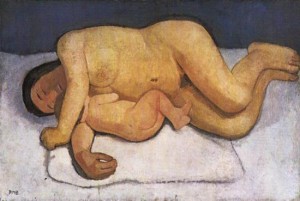
By Paula Modersohn Becker
When is a photo of a woman giving birth considered pornographic? Take your pick:
A. When it is shown in a pornographic magazine, film or website.
B. Never.
C. When it is emailed to government officials urging action to improve public health.
One could argue about A and B but this blog is about C.
Earlier this year, in Zambia, Chansa Kabwela, news editor at the feisty opposition newspaper The Post, was charged with circulating pornography with intent to corrupt public morals. What was her crime? During a nationwide strike by Zambia’s miserably paid doctors, a woman allegedly gave birth without medical assistance in a hospital car park. The baby was in a breech position and later died.
Her family sent Kabwela the photos but she found them too graphic for publication. Instead, she emailed them to the vice-president and other government officials and women’s groups, urging a negotiated end to the strike to avoid more deaths.
President Rupiyah Banda found the photos “morbid and peculiar” and Kabwela, a 29-year-old mother of two, was charged with the porn offence, which carries a five-year jail sentence. The state argued that giving birth is sacred in Zambia and the photos were disrespectful.
If giving birth is so sacred, why was the woman delivering in a car park?
Good sense prevailed and in November a judge acquitted Kabwela.
The Post has long been harassed by government for exposing corruption. This court case is one more instance, using birth, women and tradition as a cover to erode press freedom.
A very famous Christmas birth
This being the season of a famous birth, on the other side of the world, in New Zealand, a mischievous billboard about the immaculate conception has angered Catholics. 
It shows Joseph and Mary in bed. She looks blissful; he looks dejected. The kicker: “Poor Joseph. God is a hard act to follow.”
The twist is that the originator is an Anglican archdeacon who commissioned an ad agency to produce a Christmas poster. The archdeacon argues, somewhat confusedly, that the purpose was to highlight that Christmas is about love, not about Mary’s impregnation by God.
Within hours the billboard was defaced with brown paint. Well, at least this is better than rioting over caricatures of the Prophet or charging an editor with pornography.
Giving birth is charged with cultural meaning: it can be sacred, pornographic, joyful, “eculiar” or offensive. For half a million women, every year, it is deadly.
Yet these deaths do not spark the same outrage as a billboard or photographs.
My wish this Christmas is quite simple: safe delivery for women everywhere, not in a car park and not in a manger, neither holy nor unholy, whether through sex, artificial insemination or immaculate conception. Just safe.
***
Read about why maternal mortality remains so intractable here and about midwives in India.
]]>Why today? Because it’s the last of the 16 Days against Violence against Women, arguably the best known global campaign of the women’s movement, and also Human Rights Day.
Today, Sahrawi activist Aminatou Haidar starts her fourth week of [...]]]>

What's in the news on Human Rights Day?
Why today? Because it’s the last of the 16 Days against Violence against Women, arguably the best known global campaign of the women’s movement, and also Human Rights Day.
Today, Sahrawi activist Aminatou Haidar starts her fourth week of hunger strike at Lanzarote airport in the Canary Islands. She is so weak she has to be transported to court by wheelchair or stretcher. Last week, the head of UNHCR called on Spain and Morocco to resolve her issue on humanitarian grounds.
The award-winning Haidar is known as the Sahrawi Gandhi for her non-violent protests for the independence of her desert country, the Western Sahara, ruled by Morocco since 1975.
In November, the Moroccan government unlawfully withdrew her passport and deported her when Haidar returned from receiving the prestigious Civil Courage Prize in New York. In 2008 she received the Robert F. Kennedy Human Rights award.
On the other side of the world, in the Philippines, on 23 November, the eve of 16 Days, 22 women were massacred along with 35 men. The women were raped, sexually mutilated and shot in their private parts. The mass murder was instigated by a local politician-warlord and carried out by his militia. Among the victims were the wife and sister of a rival political candidate and two women lawyers who worked for him.
Believing that the Muslim tradition of respecting women would protect them from clan violence, the group was going to file papers for the candidate, along with a group of journalists. Among the 57 killed were 30 thirty media people, journalists, technicians and drivers. This is the largest single killing of journalists in history.
Earlier in November, Cuban blogger Yoani Sanchez, along with two less well-known bloggers, a woman and a man, were detained and beaten up by authorities in Havana. They were on their way to a peaceful march.
Is this cause for despair? No. These examples of violence unleashed against women in politics and media only reaffirms our commitment to denounce these crimes and seek justice.
The media now has a better tool to do this job. On 25 November, IPS presented its new handbook on reporting on women and violence. User-friendly, with an agile layout, it covers a wide spectrum of issues, from cyberstalking to trafficking, with story examples, discussion points, fact checks and additional resources. Download it here.

Do it now! No time to lose!
Email your support for Aminatou here or at: todosconaminatou@gmail.com
And do whatever you can do to end violence against women and protect human rights defenders wherever you are.
]]>
In Paris, the Chilean researcher, novelist and feminist Ana (Nicha) Vazquez Bronfman had died, aged 71. She was a beacon for a generation of Latin American women for her insights on identity and gender. One [...]]]>
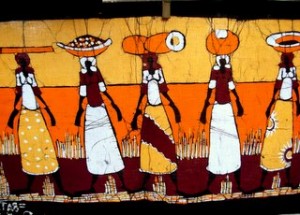
Motherhood, sisterhood, friendship.
In Paris, the Chilean researcher, novelist and feminist Ana (Nicha) Vazquez Bronfman had died, aged 71. She was a beacon for a generation of Latin American women for her insights on identity and gender. One concept she elaborated specially was “transculturation” – the permanent construction of identities in this world of global migration. In 2006 she wrote superbly about sexuality among the elderly – transgressions and secrets, she called it.
In Rome, my friend and fellow journalist Paola Rolletta underwent the next to last chemotherapy session against breast cancer. She was jubilant to see the end of the chemical bombardment. Like antiretrovirals, chemo saves lives but is no picnic.
So, in three hours, youth, disease, health and death touched me. Motherhood and friendship. Joy and sorrow.
Email has made this vertigo possible. News travel quickly and straight to our screens, to our hearts and minds.
News from friends
These days, breast cancer appears more frequently in news from friends.
One in the Dominican Republic and another in Mozambique finished their chemo last year. Paola is finishing hers in February. In Pretoria, where I live, another friend had her second chemo last Friday.
We had lunch together today and wondered if there is more breast cancer among women now than 50 years ago, or better detection. If the rates are higher, why? Lifestyle, fast food, stress, radiation from microwaves, cellphones and all the gadgets that crowd our life?
The Harvard School of Public Health estimates that the poor will account for more than 55 percent of breast cancer deaths this year. Read a very informative story on growing cancer rates among women in the developing world here.
A recent article in the New England Journal of Medicine argues that “western” influences such as changes in diet, less exercise, delayed childbirth, families with fewer children, less breast feeding, and hormone replacement therapy are all thought to increase the risk of breast cancer for women in low-income countries.
The good news is that breast cancer, like AIDS, is becoming less and less lethal, if detected and treated early.
I am so proud of my cancer-survivor friends. They have worn their baldness as a badge of courage and have acquired new wisdom.
And while we age and think about breast cancer, a younger generation moves closer to adulthood.
I wondered how to name and save this rambling text in my laptop. And I wrote – BLOG: LIFE.
]]>What had tongues wagging was citizen’s journalism, dispatches by ordinary folk about electoral irregularities from the Rovuma to the Maputo rivers.
Good stuff: government cars illegally used for campaigning, [...]]]>

The sisters can do it by themselves. By A. Vilanculos
The buzz in Mozambique during the recent elections was not the TV debate among presidential candidates debate (there is none) or their programs (all vague).
What had tongues wagging was citizen’s journalism, dispatches by ordinary folk about electoral irregularities from the Rovuma to the Maputo rivers.
Good stuff: government cars illegally used for campaigning, with cellphone pics of their registration plates (until officials wised up and started covering up plates and ministry logos with party posters). Reports of youth tearing downs other party’s posters, fistfights, intimidation, and police lack of impartiality.
On election day, people told of late opening of polling booths and misbehaviour of poll officials and party observers.
Information was relayed by a network of 110 correspondents in 11provinces (most community radio reporters) and concerned citizens who texted, phoned and emailed.
The information was fact-checked and collected in a daily bulletin produced by the Centro de Integridade Publica (an NGO anti-corruption monitor).
The bulletin, in Portuguese and English, was emailed as pdf to some 3,000 subscribers, who redistributed it to at least double this number, and was widely reproduced, for free, by the local press, especially the 60+ community radio stations.
This was watchdog citizen journalism at its best.
Thanks to the Bulletin, Mozambicans had balanced coverage of the pre-poll partial exclusion of the new kid in the block, the opposition MDM, of the instances of ballot box stuffing and the invalidation of 100,000 votes.
The Bulletin provided a credible, professional and impartial source of information, above party politics (Mozambican media is aligned with political parties, ideological blocs and economic interests).
Bits of similar projecst exist elsewhere in Africa but I don’t know of any other so well-rounded.
In Kenya, during the post-electoral conflict two years ago, people texted and phoned in reports of violence to a hotline set up by an enterprising NGO. The information was quickly confirmed and uploaded onto a web map. The press, donors, and people could keep tabs on which parts of Kenya were burning.
Ghana made good use of sms by citizen correspondents during its recent elections.
Imagine if women developed such a tool.
Imagine that the 50-50 Campaign for equal political representation in Malawi could track women candidates during the campaign and the polls, and keep tabs on the insults, the stone-throwing, and the intimidation of women candidates seen last year.
In South Africa, during the 15 days against Violence against Women that started this week, a daily bulletin could keep track of gender-based abuse, collecting reports from police, rape crisis centres, and shelters. This would provide a graphic picture of South Africa’s second epidemic, after AIDS.

Grab it now! Pic b y A. Vilanculos
Historically, women are the last to use new technologies. This time, we should grab it now!
Check the Take Back the Tech site for cool ideas on taking control of digital technology to end violence against women.
And not only digital – one idea I liked is to go for a walk with a chalk and write up your thoughts on public space.
Watch the sidewalks of my neighbourhood in Pretoria – have chalk and thoughts, will walk.
* Read IPS stories on femicide in Chile, forced sterilisation in Peru and gender-based violence elsewhere.
]]>I will call her Gabra (gift, in Amharic), for our conversation was private. I met her at a monastery near Lalibela, the mystical city of [...]]]>
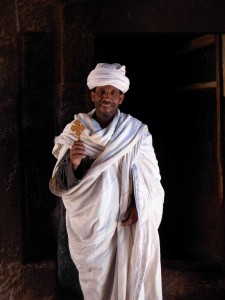
Patriarchal in all senses. By M. Sayagues
What drives a 17-year-old girl to enter a monastery? Today she is 30, and still happy about her choice. Her eyes sparkle and her laughter comes easy. She exudes peace.
I will call her Gabra (gift, in Amharic), for our conversation was private. I met her at a monastery near Lalibela, the mystical city of rock-hewn churches in northern Ethiopia.
Monastic life has a long tradition and prestige in the Ethiopian Orthodox Church. The oldest monastery dates from the 6th century. A monastic renaissance between the 13th and 16th century brought great moral and political authority to clergy.

Custodians of tradition
Gabra’s rock-hewn monastery dates from the 12th century. Her room is excavated in the pink tufa rock. Two built-in-the-rock platforms, covered with a thin mattress, do as couch and bed. An old cupboard holds a few plates and cooking utensils, three of the long green robes worn by Ethiopian peasants, the white headscarves that nuns wear, and two pairs of sandals.
For income, she and her fellow nuns weave cotton and silk into diaphanous shawls, sold at the monastery. She rises before dawn to pray – the first of daily seven prayers. Her ambition is to study theology in Addis Ababa or in Lalibela.
Gabra is not completely cut off from the world. She has a cellphone and a radio. On Sundays, relatives and friends visit.
Choices
I ask her if marriage and children ever interested her.
“It is a privilege to be single and not to have children,” she says softly, smiling but firmly. She sounds relieved.
Unmarried myself, I agree that motherhood and marriage are just one option. I understand the spiritual call, the peace of contemplation and withdrawal, of a simple lifestyle unencumbered by material things.
Yet I wonder if female genital mutilation had to do with her decision.
In Ethiopia’s eastern region, a girl might suffer genital cutting between the age of 15-17, before marriage. Her clitoris would be cut, sometimes the labia.
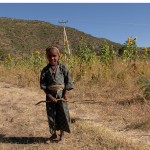
She has a right to her bodily integrity.
In Somali region, she would have infibulation at a younger age: the complete removal of her genitalia and, to preserve virginity, being stitched shut with an acacia thorn, leaving only a hole to urinate.
About three-quarters of women in Ethiopia between 15-49 have suffered some form of genital mutilation, said a government survey of 2005. The practice is fading – but too slowly, say activists.
It is not called mutilation for nothing. Sex and childbirth will be extremely painful and dangerous.
If finding a husband means suffering genital cutting, a hard mattress in a rock-hewn room is a much better place than a king-size wedding bed.
Gabra did not speak English, my male guide spoke little, and sex topics are taboo in Ethiopia, so the conversation went in another direction. Gabra was curious about my life, my work, and my daughter. 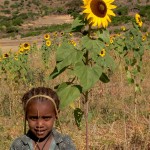
“Would you want to live like me?” she asked. “I don’t think I could,” I said. “But I feel the beauty of this simplicity.” She smiled.
Ethiopia looks and feels ancient and spiritual. Social cohesion is remarkable. But the same lifestyle that makes ferenji (foreigner, in Amharic) wax lyrical about the “biblical landscape and people” binds women to painful and dangerous traditions.
Some traditions are simply annoying. Women cannot join the rites if they are menstruating, ergo unclean. At no time of the month can women, local or foreign, enter the most sacred chapel of the Lalibela complex, Bete Mikael, where King Lalibela is buried. We are only allowed a glimpse from the door. In some monasteries, no females, including of the animal kingdom, are allowed.
Monastery visitors take leave at 5 PM (international time; in Ethiopian time, 11 in the night). I make my way down the stony path, the tufa rock glowing pink and gold in the sunset.
I am thinking that the monastery – the spiritual world – may be a blessed refuge from the hardship of being born female in a deeply patriarchal world.
Read recent IPS stories about genital cutting in Uganda, Sierra Leone and cross-border in West Africa.
]]>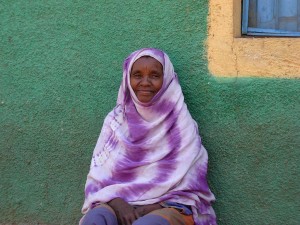
Women manage family health in Ethiopia.
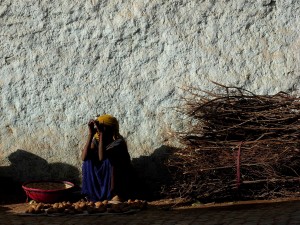
Pics by M. Sayagues
